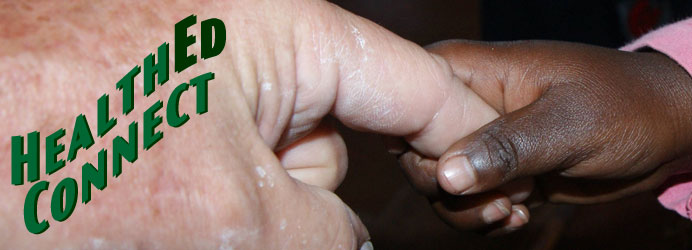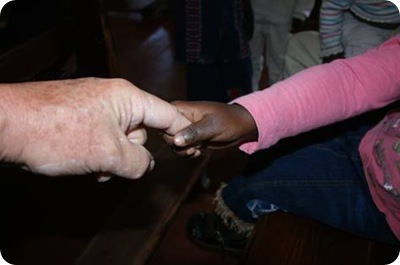Friday, July 31, 2009
July 31, 2009
When asked what they considered to be the biggest need of the orphans in their community, 104 said education followed by 25 saying a clinic was the highest need. Looks like we're on the right track with the organization of community schools.
We hope to have the results next week from the surveys Ashley and Rachael are conducting in 2 other communities.
Thursday, July 16, 2009
Summary
A long but very successful trip! We’re now eagerly awaiting the results of the community surveys being conducted in Zambia, the priority list being developed by the Zambian Steering Committee, and the official approval of a board of directors for HealthEd Connect by the Graceland Board of Trustees. But we’re not really waiting. New contacts and support possibilities emerge everyday as the news of the new OVC programs spread. Lackings Banda made us chuckle with his statement, “I use to be an electrician; now I wire people.” Like Lackings, we’re wiring programs that will impact the lives of the most needy.
By the way, did I tell you I love my new boss?
Wednesday, July 15, 2009
Malawi
From Lusaka we flew to Lilongwe, Malawi where we were met by Lackings Banda with a rental car. He led us to our motel where we ended up going to bed without supper because the electricity went out. The next morning we headed for Chisemphere, an extremely poor area, where Sinkhani (health workers) have been working for 17 years. We sat on rickety little benches in the corrugated tin roofed church while we visited and shared in a feast of shima, greens and chicken that they had prepared in the outdoor cooking hut. In spite of their own lack of resources, the Sinkhani pool funds and try to help at least one orphan at a time. They are also each donating 50 Kwacha per month (approximately $.37) into a Sinkhani banking account to pay for an as yet undetermined project. Over the past 3 years they’ve saved over 8,000 Kwacha ($59.00). They shared many stories about the power of Neosporin (as did all of the healthworkers). One of their latest patients was the chief of the village who had a large wound on the top of his foot that they were able to heal with the aid of Neosporin.
From Chisemphere we began the drive to Mzimba. We got within 35 kilometers of our destination when we blew a water hose, the car over heated, and we ended up stranded beside the road. Thank God for cell phones! We called Lackings and he scurried around, found another vehicle and a couple of mechanics, and 6 hours later came to our rescue. In the meantime we locked the car doors, hunkered down to wait, watched the sun go down, the night become pitch black, and lots of men come and go in a nearby ‘store’ that turned out to be the local tavern that sold homemade brew,. When our rescue crew finally arrived, the mechanics couldn’t fix the car on the spot so they ended up towing it to Mzimba. They didn’t have a tow rope – no problem; they just took the seat belts out of the car and made a tow rope! Lackings told us when he learned where we were stranded, he came as fast as possible since we were in an area notorious for robberies and people getting beat up. Very comforting!
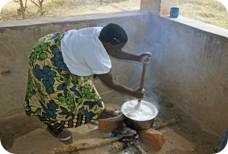 The Sinkhani in Mzimba were waiting at the church the next morning to greet us. They too sang the praises of Neosporin. Esther said, “In cold months we make [wood] fires in our homes for cooking. Sometimes the small children are involved in accidents by the fire. The medicine helps so much. Many people come to us to say ‘thank you’.” The Sinkhani continue to volunteer on a weekly basis to weigh babies and teach mothers. Last year they weighed over 26,000 babies! Their big request is for money to buy uniforms. According to them, everyone that works in the health care system has uniforms except them. They calculated the cost and said it would be $121 for fabric and a tailor for the 13 uniforms they would like to have. After 17 years of volunteer work, a $9.30 uniform seems like a reasonable request! We’ll work it into next year’s budget.
The Sinkhani in Mzimba were waiting at the church the next morning to greet us. They too sang the praises of Neosporin. Esther said, “In cold months we make [wood] fires in our homes for cooking. Sometimes the small children are involved in accidents by the fire. The medicine helps so much. Many people come to us to say ‘thank you’.” The Sinkhani continue to volunteer on a weekly basis to weigh babies and teach mothers. Last year they weighed over 26,000 babies! Their big request is for money to buy uniforms. According to them, everyone that works in the health care system has uniforms except them. They calculated the cost and said it would be $121 for fabric and a tailor for the 13 uniforms they would like to have. After 17 years of volunteer work, a $9.30 uniform seems like a reasonable request! We’ll work it into next year’s budget.
Tuesday, July 14, 2009
Zambia
Our time in Botswana was well spent as we learned from the experts in the field. We were eager, however, to move onto Zambia where we would begin looking at possibilities for our own program. Catherine Mambwe, the summer host for the WSC volunteers and the incredible friend that helped us organize our trip, met us at the airport. We were also met by Mathew and Santha Mathew, the parents of Ron Mathews, a Graceland grad and enthusiastic supporter of HealthEd Connect.
Chipulukusu - The first visit Catherine had lined up for us was the Community of Christ Chipulukusu congregation. We had expected to meet with a few of the church leaders.
 Only to be pleasantly surprised by over 150 children lined up in front of the church yelling greetings as they ran to our car. As it turned out, Pastor Dismas Mulenge and a couple of other church members organized a community school 2 months ago and already had 220 kids enrolled. As Dismas said, “We found most of the kids were just roaming about because they had no schools they could afford to go to. As a group we decided the name of the school should be Young Peacemaker School to show them the good things of being Christian.” The pastor and two other men are personally paying a modest salary for the two non-credentialed teachers. The school is open to all children. Even though government schools are theoretically free, families need to pay for uniforms, shoes, school fees, books, etc. It may only cost $10 but that’s totally out of the realm of possibility for many.
Only to be pleasantly surprised by over 150 children lined up in front of the church yelling greetings as they ran to our car. As it turned out, Pastor Dismas Mulenge and a couple of other church members organized a community school 2 months ago and already had 220 kids enrolled. As Dismas said, “We found most of the kids were just roaming about because they had no schools they could afford to go to. As a group we decided the name of the school should be Young Peacemaker School to show them the good things of being Christian.” The pastor and two other men are personally paying a modest salary for the two non-credentialed teachers. The school is open to all children. Even though government schools are theoretically free, families need to pay for uniforms, shoes, school fees, books, etc. It may only cost $10 but that’s totally out of the realm of possibility for many.
 Three of the original Kafwa health workers I trained in 1992, Joyce, Grace, and Mary, (seated closest to me) continue to provide health care for the community. They have recruited 13 new Kafwa and regularly visit homes on Tuesdays and Saturdays. Most of the visits are to homes with orphans and people with AIDS. On Fridays they hold an under-five clinic to weigh the babies. One of their new responsibilities is to refer children to the school as appropriate. When necessary, they contact other church families to help provide food where they find pressing needs.
Three of the original Kafwa health workers I trained in 1992, Joyce, Grace, and Mary, (seated closest to me) continue to provide health care for the community. They have recruited 13 new Kafwa and regularly visit homes on Tuesdays and Saturdays. Most of the visits are to homes with orphans and people with AIDS. On Fridays they hold an under-five clinic to weigh the babies. One of their new responsibilities is to refer children to the school as appropriate. When necessary, they contact other church families to help provide food where they find pressing needs.
Luanshya - Our second visit was to the mining town of Luanshya where we met with Joyness Banda (a registered nurse) and her husband, Able, along with a small group of church and community members. The Luanshya group started an OVC program in 2004, funded by Global Fund, which they named Community of Peace. At the peak of the program over 60 OVC’s were supported with uniforms, books, school fees, etc. In addition home based care (HBC) was provided to the surrounding community. The Global Fund resources ran out last year, however, and the program has shrunk accordingly with only 30 orphans currently assisted on a minimal basis with school supplies. Joyness owns the house where the program is located and continues to make it available even though the rental income from Global Fund dried up. Four teenage orphan boys currently live in the house. The group tries to support the program by raising chickens, growing and selling Maize and growing a garden.
Lunanshya is where we met Miriam, our little boss. Miriam and her widowed mother live in the community and have received assistance with food, transportation to the hospital and clothing. Even though they are both on ART therapy for HIV, the reality of this treatment became clear in a new way. Joyness told us that patients must travel many miles to the clinic to obtain medication. If they don’t have money they don’t go. In addition, the medication on an empty stomach makes them quite ill. When they don’t have food they don’t eat and subsequently quit taking their medication.
Mansa – We had an all-day ride over rutted dirt roads across the pedicle of Congo to Luapula Province. Pastors from five congregations walked/rode bicycles for long distances to attend our meeting under a tree. Each pastor reported on the specific needs of his/her area. Some mentioned the need for women’s group uniforms, others mentioned literacy and recreational needs, while another mentioned the need for increased farm production. None mentioned the need to assist orphans. When we specifically asked about the OVC population, all admitted that approximately 75% of each of their congregations was composed of children in need. They saw no way they could assist the kids, however, without outside help and assistance. Catherine spoke up and said, “Everything mentioned does not always need money to start. Take a vacation from spiritual journey and see what you are doing for physical needs of people.”
Our assessment of Mansa is that the needs are probably even greater there than those in the Copperbelt area. The leaders, however, are feeling totally overwhelmed and don’t know where to start. As one said, “We have the passion, we just don’t know how to package it.” This group does not seem ready to launch into a program at the moment. They will need mentoring before they are ready.
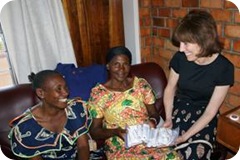 We also had the opportunity to visit with two of the original Wasaidizi (health workers) from the Congo that traveled to Mansa to meet with us. Chola (on the right) had gotten up at 4:00 a.m. to walk 6 kilometers to meet Kipili. Together they then walked another 15 kilometers to Kaboka where they caught a canoe to cross the river. When they reached the other side they rode bicycles for several miles until they could catch a bus. Sounds like an iron-man race. Amazing ladies! They briefed us on the Traditional Birth Attendant training we had arranged for them and 18 other women last year. They said 9 of the women are now government employees (with the impressive pay of $15 - $20 a month) with possibilities for the others to be employed soon. Chola delivered 8 babies and Kipili delivered 6 babies – in the last two weeks alone! Chola said the baby she delivered during my last visit had been named
We also had the opportunity to visit with two of the original Wasaidizi (health workers) from the Congo that traveled to Mansa to meet with us. Chola (on the right) had gotten up at 4:00 a.m. to walk 6 kilometers to meet Kipili. Together they then walked another 15 kilometers to Kaboka where they caught a canoe to cross the river. When they reached the other side they rode bicycles for several miles until they could catch a bus. Sounds like an iron-man race. Amazing ladies! They briefed us on the Traditional Birth Attendant training we had arranged for them and 18 other women last year. They said 9 of the women are now government employees (with the impressive pay of $15 - $20 a month) with possibilities for the others to be employed soon. Chola delivered 8 babies and Kipili delivered 6 babies – in the last two weeks alone! Chola said the baby she delivered during my last visit had been named 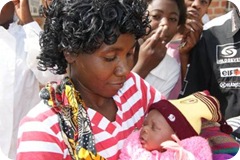 “Sherri.” When we asked about OVC’s they didn’t seem to think there was much of a problem. The community is absorbing them.
“Sherri.” When we asked about OVC’s they didn’t seem to think there was much of a problem. The community is absorbing them.
Kasompe – Back in the Copperbelt Area we went to a gathering at the Kasompe church. We expected to meet with a few of the leaders and instead were greeted by over 150 people most of whom were widows and orphans. A group of 15 or so had organized a drama, complete with a little choir, to illustrate the plight of orphans. Most of the players were orphans and widows. We met a young widow, Clementine, who is 33 years-old and has 7 children (6 living). Her husband died 2 years ago just before her twins were born. When we asked about the adorable baby she was holding, she said that was her 3 week-old grandchild of her 15 year-old daughter. Wow! The needs are definitely there and the Kasompe leadership seems eager to provide a program but hasn’t yet gotten anything launched.
Chiwempala – A small group of 10-12 adults met with us at the church where Jenny Kumwimba and Dominick are co-pastors. They are situated in the middle of a large community with great needs. There are several Outreach International employees in this congregation with community development skills. To date no programs have been started.
Organizational meeting
On our final day in the Copperbelt we convened the leadership team to plan next steps. Margaret Chilolo agreed to chair the group which we named the Steering Committee. Others present included Dismas (Chipulukusu), Joyness (Luanshya), Jenny (Chiwempala), the Kasompe pastor, Catherine Mambwe plus Rachael, Ashley, Jac and Sherri. Jac worked over an hour before the meeting to scrub permanent ink off of the whiteboard so we could use it. We used the board extensively, however, so it was definitely worth it. We really felt positive about the meeting! There’s a great leadership base ready to organize and get things moving.
Lusaka - We took a bus to Lusaka, Zambia’s capital city, to meet with officials of various OVC-related programs. Upon arrival, the bus station was a zoo but we wiggled through the crowd, pulled our roller board luggage down paths with two-inch thick layers of dust, huffed and puffed up over a foot bridge and finally turned down Cairo Boulevard to our hotel. Jac was swarmed by a group of pickpockets on the way but managed to get through the crowd without losing anything but his handkerchief.
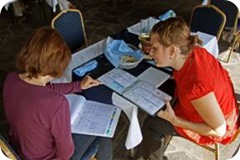 Contact Organizations - There are any number of organizations actively working on OVC programs in Zambia. We were fortunate to personally meet the directors of a number of the key programs such as CCZ, Save the Children, RAPIDS, USAID, World Vision, Churches Health Association of Zambia (CHAZ), as well as a new U.S. friend, Dana Sandstrom-Keating, now living in Zambia. These contacts were extremely helpful and will undoubtedly prove to be invaluable.
Contact Organizations - There are any number of organizations actively working on OVC programs in Zambia. We were fortunate to personally meet the directors of a number of the key programs such as CCZ, Save the Children, RAPIDS, USAID, World Vision, Churches Health Association of Zambia (CHAZ), as well as a new U.S. friend, Dana Sandstrom-Keating, now living in Zambia. These contacts were extremely helpful and will undoubtedly prove to be invaluable.
Monday, July 13, 2009
Botswana
After weeks of searching on the web and developing a wide network of contacts who work with orphans and vulnerable children (OVC’s), Jac and I, along with two World Service Corps (WSC) volunteers, Ashley Guinan and Rachael Zimmerman, arrived in Africa the first of June. We first visited Botswana which is known for its support system for OVC’s. Thanks to the internet, we had developed a number of collegial relationships and finally had the opportunity to meet our email friends. Our first stop was St. Peter’s where we were warmly greeted by Father Andrew, his wife Gladys – and 92 preschoolers who ran to give us knee hugs, smiles, and laughter as we approached! They have an attractive school-type facility with Disney characters painted on the walls. Their program primarily centers around preschool activities with two meals plus two snacks a day. In the afternoon 20 teenagers join the little ones for after-school tutoring programs. Most of the children live with grandmothers.
 Our next stop was SOS Village which is composed of sixteen homes for 300 children. Each “home” has two women assigned to cook and supervise the 12 children in their care. SOS does not run a school itself but instead sends the children to public schools. Their biggest challenge has been the inability to grow fast enough to house the huge number of children needing care. Realizing they needed to adjust their program, they recently established an outreach program to strengthen the extended family and keep the kids in the community rather than moving them into the Village.
Our next stop was SOS Village which is composed of sixteen homes for 300 children. Each “home” has two women assigned to cook and supervise the 12 children in their care. SOS does not run a school itself but instead sends the children to public schools. Their biggest challenge has been the inability to grow fast enough to house the huge number of children needing care. Realizing they needed to adjust their program, they recently established an outreach program to strengthen the extended family and keep the kids in the community rather than moving them into the Village.
Flying Mission was our next visit. Saralee was our hostess and provided very helpful information. Flying Mission’s original goal was to provide air transport for seriously ill patients. Over the years the mission has changed and they now concentrate on working with like-minded organizations that focus on HIV/AIDS. They partner and mentor other groups in tasks such as getting registered, handling money, home based care and prevention programs. A highlight of our visit was the impromptu appearance of Malcolm McArthur, the founder of Flying Mission. He wasted no time in trying to recruit us to be long-term volunteers (two to five years at least!) for his program.
Stepping Stones was our next destination. Housed in a new multi-building facility, the program provides after-school programs for 60 teenagers aged 11 to 18. Our energetic hostess, Lisa Jamu, founded Stepping Stones in 2006. Her original plan had been to provide a program for young girls but she soon decided to add boys as well and concentrate on teenagers which are often the most challenging. They had a party the day we visited for a Peace Corps volunteer who had been with them for two years. During the going away party we were treated to the Obama Call which goes like this: Clap, clap, clap. Clap, clap, clap. YES WE CAN!
Sunday, July 12, 2009
My New Boss
I love my new boss! She’s a person of few words but her occasional smile and penetrating brown eyes are sufficient incentive for me to work harder than I have ever worked before. In spite of her diminutive size, she’s able to command great respect. The pay itself isn’t great but the job she offers is immensely challenging and overflowing with rewards.
My boss’s name is Miriam. She is two years old and HIV positive.
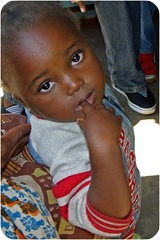 Many people would consider Miriam fortunate because she has a mother (also HIV positive) which makes Miriam a "single" orphan. "Double" orphans have neither a mother nor father. Both Miriam and her mother, Ethel, will take medication regularly for the rest of their lives. That’s assuming, of course, that they can find money for transportation to the nearest clinic where the medication is supplied by the government; that they receive enough nutrition to keep their immune systems as healthy as possible; that they don’t get discouraged and quit taking the medication because of the side effects; and that the challenges of survival itself as a widow and child in Africa don’t overwhelm them.
Many people would consider Miriam fortunate because she has a mother (also HIV positive) which makes Miriam a "single" orphan. "Double" orphans have neither a mother nor father. Both Miriam and her mother, Ethel, will take medication regularly for the rest of their lives. That’s assuming, of course, that they can find money for transportation to the nearest clinic where the medication is supplied by the government; that they receive enough nutrition to keep their immune systems as healthy as possible; that they don’t get discouraged and quit taking the medication because of the side effects; and that the challenges of survival itself as a widow and child in Africa don’t overwhelm them.
It was knowledge of Miriam and the other 12 million orphans in Africa that motivated me to launch a new career. Actually, the new career has been in the planning for months. I just hadn’t met the little boss I would work for. But I’m not the only one working for Miriam. Along with my husband, Jac, and the support of Graceland’s president, John Sellars, HealthEd Connect, a new non-governmental organization (NGO) affiliated with Graceland, was recently incorporated with the mission
To empower women and children through evidence-based health care, education, and advocacy programs.
